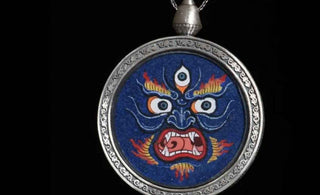
In the intricate brushstrokes of Tibet Thangka paintings, a profound tapestry of heritage unfolds, revealing the cultural significance embedded in each meticulously crafted piece. These sacred artworks, with their vibrant colors and intricate details, serve as portals to a rich tapestry of Tibetan culture, spirituality, and history.
At the heart of the cultural significance of Tibet Thangka paintings lies the preservation of heritage. These paintings are not mere artistic expressions; they are repositories of spiritual teachings, cultural narratives, and the collective wisdom of generations. As visual representations of Buddhist deities, mandalas, and cosmic landscapes, Thangkas encapsulate the essence of Tibetan Buddhism, providing a visual guide for contemplative practices and a means to transmit complex philosophical concepts.
Monasteries, as guardians of Tibetan cultural traditions, have played a pivotal role in preserving this heritage. The walls of monastic halls adorned with Thangka murals create immersive environments for religious ceremonies and meditative practices. The vibrant hues and intricate details of Thangkas become a living testament to the spiritual legacy of Tibetan Buddhism, fostering a deep connection between practitioners and the cultural heritage they embody.
Beyond religious contexts, Thangkas also narrate the cultural history of Tibet. Historical Thangkas depicting events, landscapes, and the lives of eminent figures offer insights into the socio-cultural fabric of Tibetan society. They become visual archives, documenting the transitions, triumphs, and tribulations that have shaped the Tibetan people over centuries.
The cultural significance of Tibet Thangka paintings extends to the preservation of traditional artistic techniques. Thangka painting is not merely an art form but a sacred discipline passed down through generations. The meticulous training undergone by Thangka artists ensures the continuity of techniques, styles, and iconographic conventions, safeguarding the authenticity of this ancient craft.
In the diaspora, Tibetan communities actively engage in preserving their heritage through Thangka art. Thangka painting workshops, organized by monastic institutions and cultural centers, become spaces where the younger generation learns the art form under the guidance of experienced masters. This intergenerational transmission is a dynamic process, ensuring that the cultural significance of Thangka painting continues to thrive in new environments.
Moreover, the global appreciation for Tibet Thangka paintings contributes to cross-cultural understanding and dialogue. Exhibitions, educational programs, and collaborations with international artists create opportunities for people worldwide to connect with Tibetan heritage.
Exhibitions curated around these intricate artworks, such as the awe-inspiring "Mahasthamaprapta Tibetan Thangka Pendant with the Eight Auspicious Tibetan Signs Shell," transcend geographical boundaries, inviting individuals worldwide to immerse themselves in the rich tapestry of Tibetan heritage.
Thangka exhibitions serve as cultural bridges, providing a unique opportunity for diverse audiences to engage with the spiritual and artistic legacy of Tibet. Institutions hosting such exhibitions often curate immersive experiences, allowing visitors to explore the symbolism, iconography, and craftsmanship embedded in Thangka paintings. The "Mahasthamaprapta Tibetan Thangka Pendant," with its exquisite rendering of the Eight Auspicious Tibetan Signs on a delicate shell canvas, becomes a captivating focal point, drawing attention to the intricate details that convey profound spiritual meanings.
Educational programs complement these exhibitions, offering deeper insights into the history, philosophy, and techniques behind Thangka art. Workshops led by experienced Thangka artists allow participants to try their hand at the meticulous process, fostering a hands-on understanding of the discipline. The "Mahasthamaprapta Tibetan Thangka Pendant" serves not only as an aesthetic marvel but also as a tangible example in these educational settings, illustrating the fusion of spiritual symbolism and artistic craftsmanship.
Collaborations with international artists further enrich the dialogue surrounding Tibet Thangka paintings. The "Mahasthamaprapta Tibetan Thangka Pendant," as a contemporary representation, embodies the potential for cross-cultural collaborations. Artists from diverse backgrounds, inspired by the intricate detailing and spiritual narratives of Thangkas, may find new ways to incorporate these elements into their own artistic expressions. Such collaborations not only celebrate the universality of artistic inspiration but also contribute to the evolving nature of Thangka art in a global context.
The "Mahasthamaprapta Tibetan Thangka Pendant" serves as a tangible artifact that transcends its aesthetic appeal. It becomes a conversation starter, prompting discussions on the intersection of spirituality, culture, and art. Its presence in international exhibitions and collaborative projects amplifies the voice of Tibetan heritage, fostering a shared appreciation that goes beyond borders.
In this interconnected world, the "Mahasthamaprapta Tibetan Thangka Pendant" and its counterparts become ambassadors of cultural exchange. The delicate shell canvas becomes a canvas of connection, inviting individuals from different backgrounds to explore the profound stories woven into Thangka paintings. As these intricate pendants find homes around the world, they carry with them not just the artistry of Tibet but also the spirit of dialogue and understanding that transcends cultural divides.Thangkas, as cultural ambassadors, bridge the gap between traditions, fostering mutual respect and appreciation for the diversity of human expression.
In conclusion, the cultural significance of Tibet Thangka paintings is a multifaceted tapestry woven with threads of spirituality, history, and artistic heritage. As windows to the soul of Tibetan culture, these sacred artworks serve as timeless guardians of a heritage that transcends geographical boundaries. The act of preserving this heritage through Thangka painting is not merely an artistic endeavor; it is a profound commitment to ensuring that the vibrant hues of Tibetan culture continue to illuminate the canvas of human history.

Mahasthamaprapta Tibetan Thangka Pendant with the Eight Auspicious Tibetan Signs Shell
























